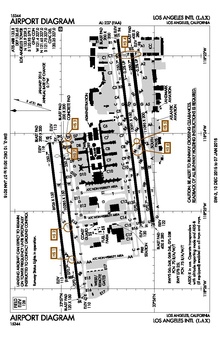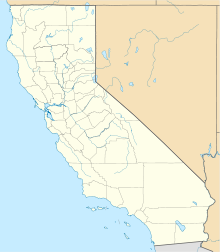Mines Field
| Los Angeles International Airport | |||||||||||||||||||||||
|---|---|---|---|---|---|---|---|---|---|---|---|---|---|---|---|---|---|---|---|---|---|---|---|
 |
|||||||||||||||||||||||
 |
|||||||||||||||||||||||
| Summary | |||||||||||||||||||||||
| Airport type | Public | ||||||||||||||||||||||
| Owner | City of Los Angeles | ||||||||||||||||||||||
| Operator | Los Angeles World Airports | ||||||||||||||||||||||
| Serves | Greater Los Angeles Area | ||||||||||||||||||||||
| Location | Los Angeles, California | ||||||||||||||||||||||
| Hub for |
Passenger airlines Cargo airlines |
||||||||||||||||||||||
| Focus city for | |||||||||||||||||||||||
| Elevation AMSL | 128 ft / 39 m | ||||||||||||||||||||||
| Coordinates | 33°56′33″N 118°24′29″W / 33.94250°N 118.40806°WCoordinates: 33°56′33″N 118°24′29″W / 33.94250°N 118.40806°W | ||||||||||||||||||||||
| Website | www.lawa.org | ||||||||||||||||||||||
| Maps | |||||||||||||||||||||||
 FAA airport diagram |
|||||||||||||||||||||||
| Location within the Los Angeles metropolitan area | |||||||||||||||||||||||
| Runways | |||||||||||||||||||||||
|
|||||||||||||||||||||||
| Statistics | |||||||||||||||||||||||
|
|||||||||||||||||||||||
|
Source: Federal Aviation Administration
|
|||||||||||||||||||||||
| Passengers (2016) | 80,921,527 |
|---|---|
| Aircraft operations (2016) | 697,138 |
| Economic impact (2012) | $14.9 billion |
| Social impact (2012) | 133.9 thousand |
Passenger airlines
Cargo airlines
Los Angeles International Airport (IATA: LAX, ICAO: KLAX, FAA LID: LAX) is the largest and busiest airport in the Greater Los Angeles Area and the state of California, as well as one of the largest international airports in the United States. It is most often referred to by its IATA airport code LAX, with the letters pronounced individually. LAX is in the southwestern Los Angeles area along the Pacific Ocean between the neighborhood of Westchester to its immediate north and the city of El Segundo to its immediate south. It is owned and operated by Los Angeles World Airports, an agency of the government of Los Angeles, formerly known as the Department of Airports.
In 2015, LAX handled 74,936,256 passengers, an increase of 6 percent from the previous year, making it the world's seventh busiest airport by passenger traffic. The airport holds the claim for "the world's busiest origin and destination (O & D) airport," and has for many years. To wit, relative to other airports, many more travelers begin or end their trips in Los Angeles than use it as a connection. The airport also was the world's third busiest by aircraft movements. It is also the only airport to rank among the top five U.S. airports for both passenger and cargo traffic.
While LAX is the busiest airport in the Greater Los Angeles Area, other airports, including Bob Hope Airport, John Wayne Airport, Long Beach Airport, and Ontario International Airport, also serve the region. It is also notable for being one of the few U.S. airports with four parallel runways.
...
Wikipedia



